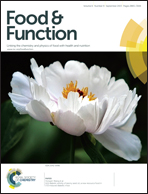Mechanism of the antiadipogenic-antiobesity effects of a rice hull smoke extract in 3T3-L1 preadipocyte cells and in mice on a high-fat diet
Abstract
The present study investigated the inhibitory effects of a rice hull smoke extract (RHSE) against adipogenesis in 3T3-L1 preadipocyte cells and in mice fed high fat (HFD) and normal (ND) diets. At concentrations of 0.1% and 0.5%, RHSE was shown to reduce the cellular lipid content in MDI-induced 3T3-L1 cells by about 72% and 88%, respectively, compared to that in control cells without RHSE, indicating a strong antiadipogenic effect. This result was supported by the finding that the expression of the adipocyte differentiation marker adiponectin was suppressed. MTT and lactate dehydrogenase (LDH) release assays showed that RHSE doses of up to 0.5% (v/v) were not cytotoxic to the 3T3-L1 cells. RHSE activates AMP-activated protein kinase (AMPK) through raising the phosphorylated ratio during the early phase of cell differentiation, and western blot analysis showed that it dose-dependently inhibited the expression of the peroxisome proliferator-activated receptor-γ (PPARγ), CCAAT-enhancer binding protein (C/EBPα), and sterol regulatory element-binding protein 1c (SREBP-1c) at the late stage of differentiation. The antiadipogenic properties of RHSE were confirmed in vivo using experimental obese mice on a high-fat diet. Dietary supplementations of 0.5% and 1% RHSE resulted in a reduction at the end of the 7-week feeding study of body weight gain of 66.9% and 72.5%, respectively, a reduction of epididymal white adipose tissue weight by up to 87.9%, restoration of elevated total cholesterol and triglyceride levels in plasma and liver to those observed in the ND-fed mice, normalization of distorted serum leptin and adiponectin levels, and restoration of liver weight and glutamate oxaloacetate transaminase/glutamate pyruvate transaminase (GOT/GPT) enzymes, blood urea, and serum creatinine to the normal control levels observed in the ND-fed mice. As was found in the 3T3-L1 cells, RHSE up-regulated AMPK phosphorylation and down-regulated PPARγ, C/EBPα and SREBP-1c protein expression in the epididymal white adipose tissues. These results indicate that RHSE inhibits the AMPK signaling pathway in mice and might serve as an antiobesity multifunctional food additive.


 Please wait while we load your content...
Please wait while we load your content...